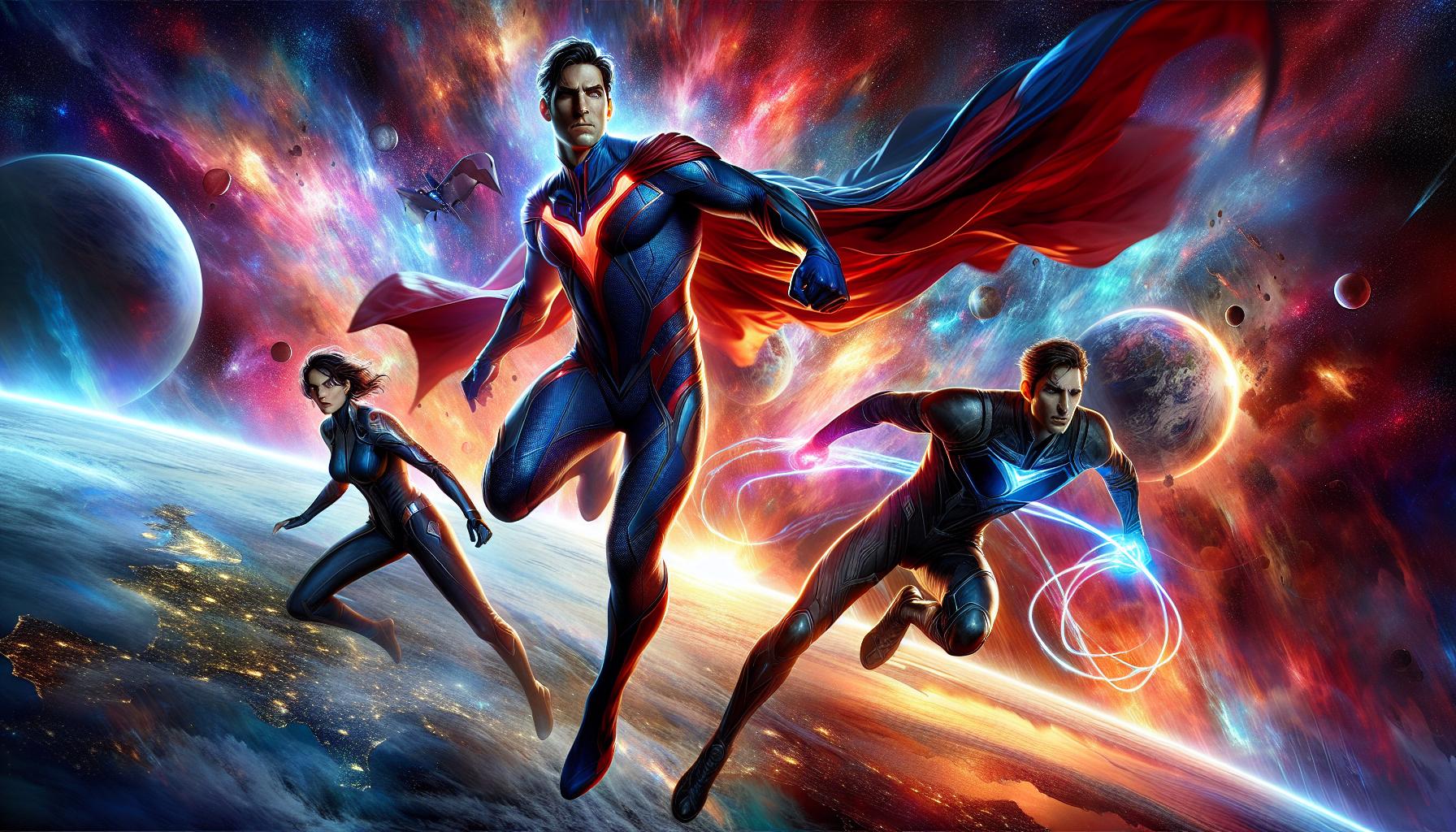
As a lifelong DC Comics fan, I’ve been eagerly anticipating the release of Justice League: Crisis on Infinite Earths. This epic crossover event promises to shake the foundations of the DC Universe and bring together heroes from across the multiverse.
Drawing inspiration from the groundbreaking 1985 comic series, this adaptation is set to redefine superhero storytelling on the big screen. With an all-star cast featuring iconic characters like Superman, Batman, and Wonder Woman, alongside lesser-known heroes from parallel worlds, “Crisis on Infinite Earths” is poised to be a game-changer for the DC Extended Universe.
Key Takeaways
- “Crisis on Infinite Earths” is a groundbreaking comic book storyline that reshaped the DC Universe and introduced the concept of the multiverse
- The event features an extensive cast of characters, including iconic heroes like Superman, Batman, and Wonder Woman, as well as lesser-known characters from parallel worlds
- The main antagonist, Anti-Monitor, threatens to destroy all positive matter universes, leading to the merging of multiple Earths into a single, streamlined universe
- The storyline had a significant impact on DC Comics, simplifying continuity, allowing for character deaths and resurrections, and setting a new standard for high-stakes storytelling
- Adapting “Crisis on Infinite Earths” for film and TV presents challenges in terms of scale and complexity, but offers exciting possibilities for creating a cinematic multiverse
Justice League: Crisis on Infinite Earths
Justice League: Crisis on Infinite Earths is a groundbreaking comic book storyline that reshaped the DC Universe. It’s a multiversal epic that brings together heroes from various parallel worlds to face an existential threat.
Comic Book Origins
The original Crisis on Infinite Earths was a 12-issue limited series published by DC Comics in 1985-1986. Written by Marv Wolfman and illustrated by George Pérez, this event aimed to streamline DC’s convoluted continuity. It featured a massive cast of characters from different Earths, including iconic heroes like Superman, Batman, and Wonder Woman. The series’ impact on DC’s publishing history can’t be overstated, as it consolidated multiple parallel universes into a single, coherent reality.
Multiverse Concept
Crisis on Infinite Earths introduced the concept of the DC Multiverse to a wider audience. The multiverse consists of numerous parallel Earths, each with its own unique versions of familiar characters and storylines. In the original comic, the villain Anti-Monitor threatens to destroy all realities, forcing heroes from different Earths to unite. This concept allows for creative storytelling possibilities, enabling characters from various timelines and alternate realities to interact. The multiverse has since become a cornerstone of DC’s narrative framework, allowing for complex crossovers and alternate reality stories.
Key Characters and Teams Involved

The “Crisis on Infinite Earths” storyline features an extensive cast of characters from across the DC Multiverse. Here’s a breakdown of the key players and teams that play crucial roles in this epic narrative.
The Justice League
The Justice League stands at the forefront of the battle against the Anti-Monitor. This iconic team includes:
- Superman: The Man of Steel from Earth-One, leading the charge
- Batman: The Dark Knight, providing strategic insight
- Wonder Woman: The Amazon warrior, bringing strength and wisdom
- The Flash (Barry Allen): The Scarlet Speedster, central to the Crisis
- Green Lantern (Hal Jordan): Wielding the power of willpower
- Aquaman: The King of Atlantis, defending both land and sea
- Martian Manhunter: The shape-shifting alien with telepathic abilities
Other notable heroes joining the fight:
- Supergirl: Superman’s cousin from Earth-One
- The Flash (Jay Garrick): The original speedster from Earth-Two
- Green Arrow: The skilled archer and social justice warrior
- Black Canary: The martial arts expert with a sonic scream
- Firestorm: The Nuclear Man, a fusion of two individuals
Notable Villains
The Crisis brings together a formidable array of antagonists:
- Anti-Monitor: The primary antagonist, seeking to destroy the Multiverse
- Monitor: Anti-Monitor’s counterpart, initially perceived as a threat
- Psycho-Pirate: A villain manipulated by the Anti-Monitor
- Brainiac: The superintelligent alien android
- Lex Luthor: Superman’s arch-nemesis from Earth-One
- Deathstroke: The deadly assassin and mercenary
- The Secret Society of Super-Villains: A group of Earth-One villains
- The Crime Syndicate: Evil counterparts of the Justice League from Earth-Three
Major Plot Points and Storylines

The “Crisis on Infinite Earths” storyline revolves around a cosmic threat that endangers the entire multiverse. This epic narrative unfolds across multiple dimensions, featuring pivotal events that reshape the DC Universe.
The Anti-Monitor’s Threat
The Anti-Monitor emerges as the primary antagonist, seeking to destroy all positive matter universes. Its sinister plan involves unleashing waves of antimatter, obliterating entire realities. Heroes from various Earths band together to combat this existential threat, facing devastating losses and impossible odds. The Anti-Monitor’s actions trigger a chain reaction that threatens to unravel the fabric of the multiverse itself.
Merging of Multiple Earths
As the crisis escalates, the remaining Earths begin to merge, creating a unified reality. This convergence causes chaos and confusion among heroes and villains alike. Characters from different Earths suddenly find themselves coexisting, leading to unexpected alliances and conflicts. The merging process results in the creation of a single, streamlined universe, fundamentally altering the DC continuity. This event allows for the reimagining of classic characters and the introduction of new storylines, setting the stage for future DC narratives.
Impact on DC Comics Universe

The “Crisis on Infinite Earths” event fundamentally reshaped the DC Comics universe, leaving an indelible mark on its continuity and characters. Its effects rippled through subsequent storylines, shaping the DC landscape for years to come.
Continuity Changes
“Crisis on Infinite Earths” streamlined DC’s complex multiverse into a single, unified continuity. This consolidation eliminated decades of conflicting storylines and alternate versions of characters, creating a more coherent narrative framework. The event allowed for a fresh start, enabling writers to reimagine classic heroes and villains without the burden of convoluted backstories. It introduced the concept of a shared universe, where all DC characters coexist on one Earth, fostering more frequent crossovers and interconnected storytelling. This new continuity also provided opportunities to modernize outdated characters and update their origins to resonate with contemporary audiences.
Character Deaths and Resurrections
The “Crisis” event was notable for its high-stakes storytelling, resulting in the deaths of several prominent characters. Supergirl’s sacrifice in battle against the Anti-Monitor became an iconic moment in comic book history. The Flash (Barry Allen) met a heroic end while saving the multiverse, leaving a lasting impact on the Flash legacy. These deaths carried significant weight, as they were initially portrayed as permanent, raising the stakes for future storylines. However, the event also set a precedent for character resurrections, as some heroes who perished during the Crisis eventually returned in later narratives. This cycle of death and rebirth became a recurring theme in DC Comics, influencing how readers and creators approached the concept of mortality in superhero storytelling.
Adaptation Possibilities for Film and TV
Adapting “Crisis on Infinite Earths” for film and TV presents exciting opportunities and unique challenges. The scope and complexity of the storyline offer potential for groundbreaking visual storytelling across multiple platforms.
Challenges of Bringing Crisis to Screen
Adapting “Crisis on Infinite Earths” for screen faces significant hurdles. The sheer scale of the multiverse concept requires extensive visual effects budgets to portray multiple Earths and characters convincingly. Condensing the complex narrative into a coherent film or limited series demands careful scripting to avoid overwhelming audiences unfamiliar with DC lore. Character licensing issues may restrict the use of certain heroes or villains, potentially limiting the full impact of the crossover event. Balancing screen time for numerous characters while maintaining a focused plot presents a major challenge for directors and writers.
Potential for a Cinematic Multiverse
A cinematic adaptation of “Crisis on Infinite Earths” opens doors for an expansive DC multiverse on screen. This storyline provides a framework to unite various DC film and TV properties, including past and present iterations of characters. It offers opportunities to explore alternate versions of beloved heroes, introducing fresh interpretations and storylines. The multiverse concept allows for creative crossovers between different mediums, potentially bridging animated series with live-action films. This adaptation could serve as a cornerstone event, reshaping the DC Extended Universe and setting the stage for future interconnected stories across multiple platforms.
Legacy and Influence on Superhero Comics
“Crisis on Infinite Earths” left an indelible mark on the superhero comic book landscape, reshaping not only DC Comics but influencing the entire industry. Its impact extends far beyond its initial publication, setting new standards for storytelling and universe-building.
Redefining Continuity
The event’s most significant contribution was its approach to continuity. By merging multiple universes into one, DC created a template for other publishers to streamline their own complex histories. This concept of a “reboot” became a powerful tool for rejuvenating aging franchises and attracting new readers.
Raising the Stakes
“Crisis” introduced a new level of consequences in superhero narratives. The deaths of major characters like Supergirl and Barry Allen showed readers that no one was safe, elevating the emotional impact of storylines. This trend of high-stakes storytelling continues to influence modern comics, with events often promising lasting changes to their respective universes.
Crossover Events
The success of “Crisis” popularized the concept of the comic book crossover event. These large-scale narratives, involving multiple series and characters, became a staple of superhero publishing. Annual events like Marvel’s “Secret Wars” or DC’s subsequent crises owe their existence to the groundwork laid by “Crisis on Infinite Earths.”
Multiverse Exploration
While “Crisis” initially simplified DC’s multiverse, it paradoxically opened the door for more complex explorations of parallel realities. The concept of a multiverse became a rich source of storytelling, allowing for alternate versions of characters and “what-if” scenarios that continue to captivate readers.
Visual Storytelling
George Pérez’s intricate artwork in “Crisis” set a new standard for visual storytelling in comics. His ability to render complex scenes with numerous characters influenced generations of artists, pushing the boundaries of what was possible on the comic page.
Character Development
The event provided opportunities for character growth and redefinition. Heroes faced impossible odds, made difficult choices, and emerged changed. This approach to character development in the context of large-scale events became a model for future storytellers.
Legacy Characters
“Crisis” introduced the concept of legacy heroes on a grand scale. Characters like Wally West taking up the mantle of The Flash after Barry Allen’s death became a recurring theme in superhero comics, allowing for generational storytelling and character evolution.
Comic Book
Justice League: Crisis on Infinite Earths stands as a watershed moment in comic book history. It’s a testament to the power of storytelling and the enduring appeal of superheroes. As we look forward to its potential adaptation I’m filled with anticipation for how it’ll reshape the DC Universe on screen.
This epic tale of multiversal proportions promises to bring together beloved characters in ways we’ve never seen before. It’s not just a story it’s a reimagining of what’s possible in superhero narratives. I can’t wait to see how this groundbreaking event will inspire the next generation of comic book fans and creators alike.







